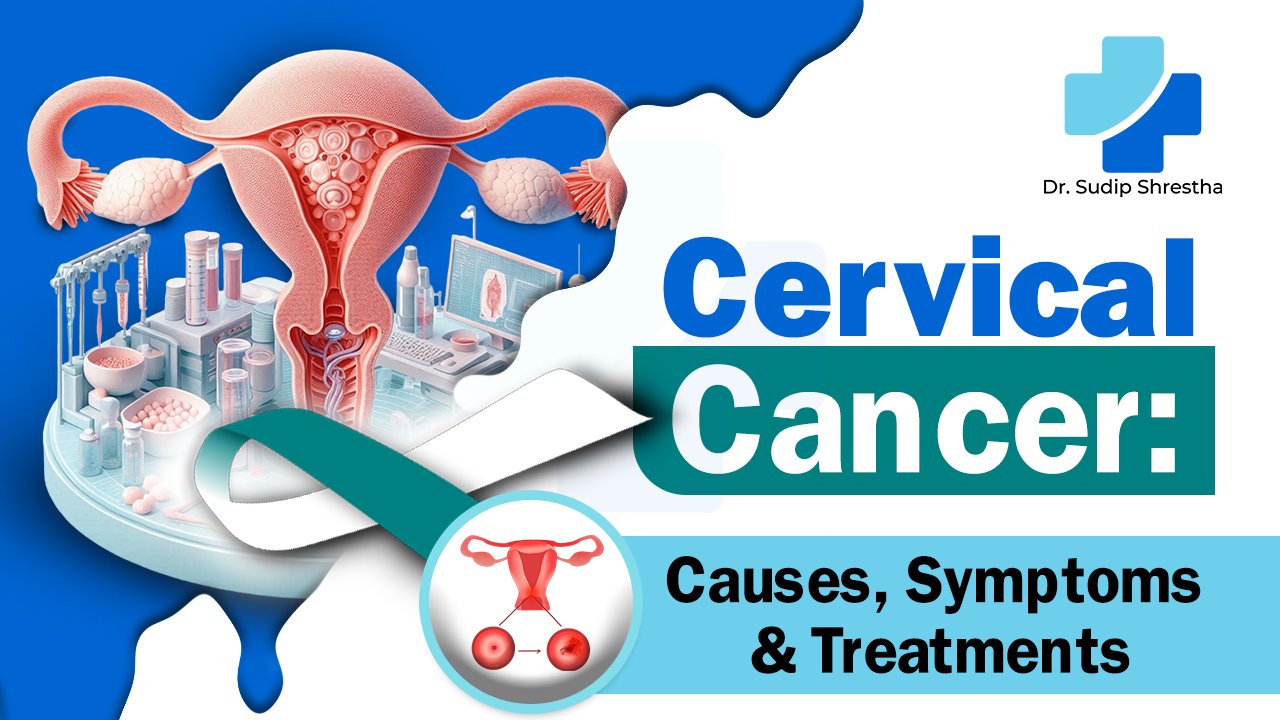Cervical cancer is a preventable yet serious health condition affecting women worldwide. In recent years, advancements in screening, vaccination, and treatment have significantly improved outcomes for patients. Despite these improvements, understanding cervical cancer remains crucial in combating its impact. In this comprehensive guide, we explore cervical cancer’s causes, symptoms, treatments, and prevention measures, with insights from the expertise of Dr. Sudip Shrestha, a prominent oncologist.
What is Cervical Cancer?
Cervical cancer develops when abnormal cells in the cervix multiply uncontrollably. The cervix is the lower part of the uterus, connecting to the vagina. Cervical cancer often starts as precancerous changes in the lining of the cervix.
There are two main types of cervical cancer:
- Squamous Cell Carcinoma: The most common form, responsible for 70% of cases.
- Adenocarcinoma: Less common but harder to diagnose, arising in the glandular cells higher in the cervix.
While the disease is treatable if detected early, it can progress to life-threatening stages without timely intervention.
Causes of Cervical Cancer
Almost all cases of cervical cancer are linked to persistent infection with high-risk types of the human papillomavirus (HPV). This sexually transmitted infection is common, but only certain strains cause cancer.
Major Risk Factors
- HPV Infection: Persistent infection with high-risk HPV strains like HPV-16 and HPV-18 is the primary cause.
- Smoking: Smoking damages cervical cells, increasing vulnerability to HPV.
- Weakened Immune System: Conditions like HIV or immunosuppressive medications heighten risk.
- Prolonged Use of Contraceptive Pills: Long-term use (5+ years) may slightly raise the risk in HPV-positive women.
- Diethylstilbestrol (DES) Exposure: If a woman’s mother took DES during pregnancy (1939–1971), her cervical cancer risk increases.
It’s important to note that HPV infections are common, but most resolve without causing cancer. Regular screening is vital to detect abnormalities early.
Symptoms of Cervical Cancer
In its early stages, cervical cancer rarely shows symptoms, making regular screening essential. However, as it progresses, the following symptoms may appear:
- Unusual Vaginal Bleeding: Between periods, after intercourse, or post-menopause.
- Heavier or Longer Periods: Uncharacteristically heavy or prolonged menstrual bleeding.
- Pelvic Pain: Persistent or sharp pain in the pelvic region.
- Pain During Intercourse: Discomfort or pain during sexual activity.
- Abnormal Vaginal Discharge: Changes in color, smell, or consistency.
- Post-Menopausal Bleeding: Any bleeding after menopause warrants immediate attention.
If you notice these symptoms, consult a healthcare provider promptly. Early intervention significantly improves outcomes.
Diagnosis of Cervical Cancer
Early detection is critical in cervical cancer care. Diagnosis typically follows a positive cervical screening test.
Diagnostic Procedures
- Cervical Screening Test (HPV Test): Replaces the traditional Pap smear, detecting HPV infections early.
- Colposcopy with Biopsy: A specialist examines the cervix with a colposcope and may take a tissue sample for analysis.
- LLETZ or Cone Biopsy: Used to remove and examine abnormal cervical tissue.
- Imaging Tests: MRI, CT scans, or PET scans help assess the cancer’s spread.
Staging of Cervical Cancer
Cervical cancer is staged from 1 to 4 based on its spread:
- Stage 1: Cancer is confined to the cervix.
- Stage 2: Cancer extends beyond the cervix but hasn’t reached the pelvic wall.
- Stage 3: Cancer invades the pelvic wall or lower part of the vagina.
- Stage 4: Cancer spreads to distant organs like the lungs or liver.
Staging guides treatment plans and predicts outcomes.
Treatment for Cervical Cancer
The choice of treatment depends on the cancer’s stage, size, and the patient’s overall health. The primary treatments include:
1. Surgery
Surgery is the mainstay for early-stage cervical cancer. Procedures include:
- Cone Biopsy: Removes a small, cone-shaped portion of the cervix.
- Hysterectomy: Surgical removal of the uterus, often with the cervix.
2. Radiation Therapy
High-energy rays target and destroy cancer cells. It is often combined with chemotherapy for advanced stages.
3. Chemotherapy
Drugs like cisplatin and fluorouracil kill cancer cells or shrink tumors. Chemotherapy is used for advanced or metastatic cases.
4. Immunotherapy and Targeted Therapy

Newer treatments like immunotherapy boost the immune system’s ability to fight cancer, offering hope for cases resistant to traditional therapies.
Role of the Treatment Team
Managing cervical cancer requires a multidisciplinary approach:
- Gynaecological Oncologist: Leads diagnosis and surgical treatment.
- Radiation Oncologist: Designs and delivers radiation therapy.
- Medical Oncologist: Oversees chemotherapy regimens.
- Cancer Care Coordinators: Support and guide patients through their treatment journey.
Each specialist plays a pivotal role in ensuring optimal outcomes.
Preventing Cervical Cancer
Cervical cancer prevention focuses on vaccination, regular screening, and adopting healthy lifestyle choices.
1. HPV Vaccination
Vaccines like Gardasil 9 protect against high-risk HPV types. The vaccine is most effective when administered to pre-teens (ages 12–13) but is recommended for everyone aged 12–25. While vaccinated individuals still need regular screening, the vaccine drastically reduces the risk of cervical cancer.
2. Cervical Screening
The Cervical Screening Test detects HPV infections before cancer develops. Women aged 25–74 should undergo screening every five years.
3. Healthy Lifestyle
- Avoid smoking.
- Practice safe sex to reduce HPV transmission.
- Maintain a healthy immune system through a balanced diet and exercise.
Cervical Cancer Survival Rates and Prognosis
Cervical cancer has an excellent prognosis when detected early. The five-year survival rate for localized cervical cancer is over 90%. However, survival decreases significantly in advanced stages. Factors influencing prognosis include:
- Type and stage of cancer.
- Overall health and age.
- Response to treatment.
Fertility concerns are common for women undergoing treatment. If having children is a priority, consult your doctor about fertility-preserving options before starting therapy.
Insights from Dr. Sudip Shrestha

Dr. Sudip Shrestha, an esteemed oncologist in Nepal, emphasizes the importance of early detection and holistic care in cervical cancer treatment. His expertise in oncology and compassionate patient care make him a leading figure in cancer management. Dr. Shrestha’s approach underscores the need for community awareness and proactive health measures, including vaccination and regular screening.
Conclusion
Cervical cancer is a preventable and treatable condition, provided it is detected early. With advancements in HPV vaccination and screening, the world is moving closer to eradicating cervical cancer as a major health concern. Individuals must prioritize regular screenings, adopt healthy habits, and educate themselves about the risks and symptoms.
Dr. Sudip Shrestha’s work and the experiences of countless survivors highlight the critical importance of awareness, prevention, and comprehensive care. Take charge of your health today to protect yourself and your loved ones from cervical cancer.




1 thought on “Cervical Cancer: Causes, Symptoms & Treatments”